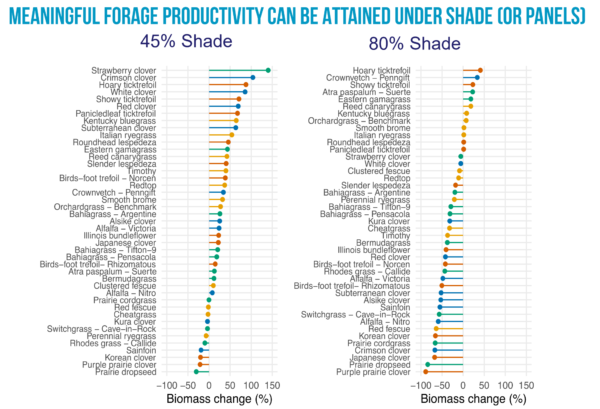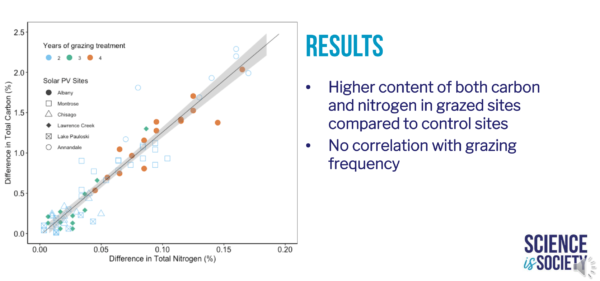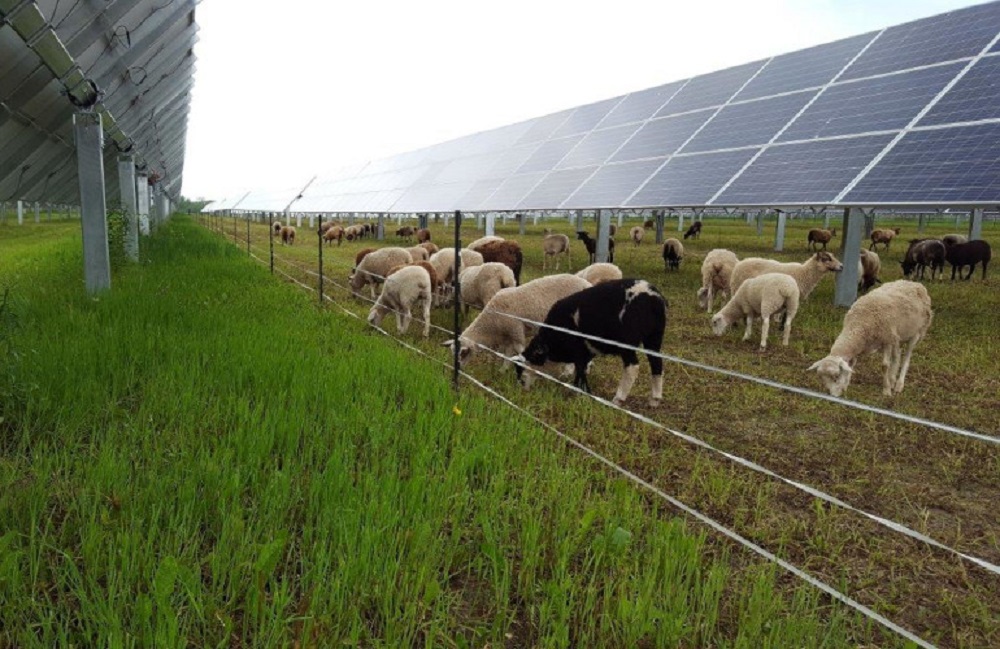In a recent presentation, titled Managed Sheep Grazing Can Improve Soil Quality and Carbon Sequestration at Solar Photovoltaic Sites, researchers from Temple University investigated the effects of periodic sheep grazing on soil properties. Micro and macro nutrients, carbon storage, and soil grain size distribution at six commercial solar PV sites were compared to undisturbed control sites.
The authors point to existing studies which show biomass production of forage species under shade (e.g Pang et al, 2019 Agroforest Syst (2019) 93:11–24) Data from the: Horticulture and Agroforestry Research Center (HARC), New Franklin, Missouri. One of the more interesting findings of this research describes the relationship between levels of shading and the biomass production of various plants, shown in the chart below. The analysis found that the ‘meaningful forage productivity’ of most of their chosen ruminant appropriate species significantly increased under 45% shade, while most plants under 80% shade saw a marked decrease in biomass volume.

The results align with prior research from the University of Oregon, which found that solar panels altered the microclimate variables of mean air temperature, relative humidity, wind speed, wind direction, and soil moisture. This improved water efficiency, allowing for much greater biomass growth, drove a 90% increase in grasses for sheep and cows.
The extensive list of plants examined is a definite positive, as the rate of installation for ground-mount solar power accelerates. Efforts are currently being made by the U.S. Department of Agriculture’s National Institute of Food and Agriculture and University of Illinois to determine which row crops, foraging crops, and specialty crops are best to couple with solar panels in agrivoltaic settings.
In this project’s case, land at the facility has been managed by the Minnesota Native Landscapes’ Conservation Grazing Program. Their approach to regenerative land management relies on the planned impact of livestock grazing. This approach gives holistic consideration to the type of soil and plants, as well as the animals which will be grazing, with an eye towards rehabilitating the soil over time. The group works with sheep, bison, cattle, and goats in their land conservation programs.
Across the six sites, researchers allowed 500-700 sheep to graze the sites two to three times per year.
The researchers’ early estimates suggest that an acre of grazed native plants may improve soil at a rate of one ton of sequestered carbon per year, and that carbon and other nutrients may accumulate for 12 to 15 years before the soil is fully saturated.

The total exchange capacity of the soil (a soil fertility measurement based on how many cations can be retained on soil surfaces) showed a marked improvement at four of the six sites, and an overall increase in the estimated nitrogen release, ammonia, and nitrate was found at all but one of the sites. A similar increase was seen in other nutrients as well, including Mg, Na, K, P, Ca, and S.
This data points in the same direction as an analysis of Upper Midwest solar power facilities integrating natural prairie grasses, which sequester roughly half a ton of carbon per acre without livestock. That study demonstrated a 65% greater carbon retention compared to a purely agricultural scenario, and 35% improvement over a solar-turfgrass scenario.
This article was amended on Feb. 8, 2022 to note the separate study on biomass.
This content is protected by copyright and may not be reused. If you want to cooperate with us and would like to reuse some of our content, please contact: editors@pv-magazine.com.








Since sheep, bison, cattle, and goats are ruminants, were these animals’ methane emissions factored in ?
It would be nice if a figure like that could be stated clearly, and usefully. I’m afraid it requires a too much context, and even then it is still very difficult to define.
Long term, its important to remember that the last time the climate was carbon-stable, 60 million bison and 62 million white-tailed deer roamed North America. Today we have 500,000 bison and 30 million deer. Those were the dominant populations, but it’s important to remember that there were (and still are) many more millions more non-ruminants who were (and are still) producing plenty of methane.
Today we have an ~330M humans in the US alone, compared to the highest population of Native Americans, 18M.
So while we’ve got these obvious methane-producing factors listed above, there are still too many factors for us to settle on any ‘apples to apples’ comparisons in the near future.
Grass-fed ruminants like the ones in this article tend to produce more methane while eating grass than feed. One reason is that grass fed ruminants take longer to put on weight, so they live longer and emit more methane. On the other hand, those increased emissions are offset by a much more direct path to carbon sequestration: excretion of nutrients + microbiome directly on the field where it’s needed saves the fossil fuels needed to spread manure. The correct answer to your question depends on exactly which factors we compare, and just making sure all factors are included is tough to get right. Even though we’re only scratching the surface, real life gets so complicated and difficult to measure that any attempt to compare values without pages context would be some level of dishonest.
Other factors to be aware of: there is still SOME controversy over the exact climate science describing how various pollutions interact in the upper atmosphere, in the presence of sunlight.
On a positive note, research has demonstrated that dietary additives can significantly reduce methane production in livestock.
I hope I have muddied the waters enough.
Oh yes, quite muddied! Would a better grazing animal possibly be a monogastric species like rabbits? Rabbits have the added benefit of being white meat. I suspect though that the rabbit fence requirement may add cost but then the panels would not have to be raised so high. Also, rabbits and chickens can co-pasture, chickens eat grass too. Chicken roosts and nests could use the solar PV support structures, so even the structures are dual-use. It just seems to me that ruminants are not the best choice.
That’s a great idea! But having grown up on a farm with chickens, I can caution you that chickens and rabbits raised outdoors are easily found by hawks, raccoons, foxes, wolves, etc. So one would have to spend a whole lot of time and money trying to keep them safe from predators.
Michael
I raise chickens, rabbits, and sheep and you are right about the predators. Solar farms seem to always have fences around them so maybe a different type of fence (electrified mesh?) would work. I see a number of “free-range” chickens raised using only an electrified mesh fence and a shelter for the animals. In my large chicken yard I have eliminated the threat from flying predators by placing rabbit hutches throughout so the birds cannot swoop in without crashing into the hutches. I have found several injured birds that have tried. The cost of proper fences should be offset by avoiding the cost of raising the solar panels. The solar PV developers I have talked to say raising the panels is a significant cost. Wolves and foxes (and coyotes and cougars) kill sheep and lambs too.